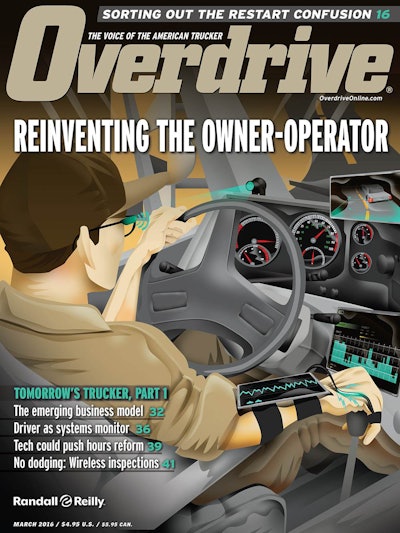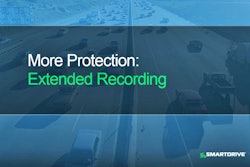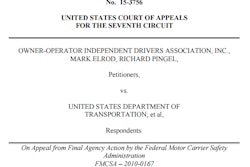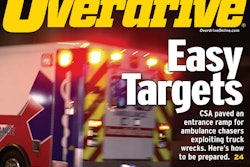Much of the monitoring equipment that many larger carriers are investing in also gives them a critical edge in legal disputes. Video cameras, which also are used in ongoing training for drivers who exhibit unsafe habits, also can prove what really happened in a crash. Electronic logging devices, beyond their primary function, can remove a common line of legal attack by encouraging and proving bedrock compliance with hours of service.
 Post-crash civil litigation can be viewed as at least contributing to carriers’ uptake of monitoring equipment. For more about the future of such equipment as it relates, access installments in Overdrive‘s March/April “Tomorrow’s Trucker” multipart feature via this link.
Post-crash civil litigation can be viewed as at least contributing to carriers’ uptake of monitoring equipment. For more about the future of such equipment as it relates, access installments in Overdrive‘s March/April “Tomorrow’s Trucker” multipart feature via this link.Josh Fulmer, a risk management manager at Florida-headquartered Carroll Fulmer Logistics, says his company has had two big settlements in the past 10 years. One was settled out of court after a Fulmer truck rear-ended an auto driver. The insurance company “ended up awarding him a little over $4 million,” Fulmer says.
The company went to trial in a “rear-ending accident in California that happened nine or 10 years ago,” Fulmer says, and in which the company believed its driver was in the right. “There was a lot going on with the insurance companies on the back side” of the case, and it dragged out over nearly a decade.
To ward off such expensive, time-consuming cases, Carroll Fulmer began using cameras to gather video evidence. The SmartDrive dual-camera systems in place there today produce such good results that they shortcut the satisfaction of “going to court and having this ‘gotcha’ moment.” When video evidence is in play, Fulmer says, “it just never gets that far.”
He describes a case of attempted insurance fraud. “We had a gentleman pull in front of us at 65 miles per hour and slam on his brakes, and we rear-ended him. Our driver got charged. A day or two later, we were able to get that video, and they retracted their citation.” Without the video, it could have been simply a “he-said she-said” trial with an officer’s citation working against the trucking company.
Carroll Fulmer does carry excess insurance – “up to $10 million, $8 million over our first $2 million,” he says, with a high deductible to lower the premiums. The investment in the cameras, Fulmer believes wholeheartedly, “lowers our exposure” with the ability to “tell the true story of what really happened.”
Dragging a suit out when there’s a scarcity of evidence, too, is unappealing because attorney’s fees accrue. “With a camera system, you know what you have,” Fulmer says. “If we’re at fault and we know it” beyond a shadow of a doubt, “we have no problem paying the injured party, but we don’t want to pay the attorneys.”
Bill Strimbu’s Nick Strimbu Inc. fleet moved to iDrive’s dual road- and driver-facing camera system (iDriveglobal.com). It’s not unlike Fulmer’s SmartDrive cams, but with a crucial difference. Both SmartDrive and Lytx DriveCam, two industry leaders, include a third-party review service for all critical events. Most of those events, with parameters determined by the fleets, are used for training.
The iDrive system is in some ways more intrusive because it gives fleet managers the potential to monitor drivers in real time. But as the Strimbu fleet has it set up, the company monitors captured events after the fact and on their own, rather than paying for any third-party review service. When drivers fuel at the central terminal in Brookfield, Ohio, personnel download the data from the camera. “We like to review our own events,” Bill Strimbu says. “A lot of these camera manufacturers don’t allow you to do that.”
If the volume of events is sufficiently low, having little or no direct ongoing costs could be an appealing option for many of the smallest fleets. What’s more, reflecting a trend that’s just now gaining steam, “the insurance company we’re with pays half the cost of the camera,” each of which costs about $300 in total, Strimbu says.
| Protect yourself **Buy as much liability insurance as you can afford and still maintain a healthy profit margin. **Get a forward-facing camera (or dual-view, with in-cab vid capability) to record accidents. **Begin using electronic logs to encourage and better document 100 percent hours of service compliance. **Devise a system for routine saving and purging of data from your ECM and other equipment, such as dashcams. **Get proper treatment for any medical conditions, especially sleep apnea, to remove any hint of impairment. |
While many owner-operators are investing in road-facing dashcams, they’ve seen no reason to buy driver-facing cameras to monitor themselves, though some have gone that route with the employment of two consumer dashcams, one pointing at the road, one back into the cab. Moseley believes that might be the right move in light of litigation.
“I like the camera pointing both ways,” he says as an attorney. “You’re able to eliminate that you’re not on the phone,” among other things. “You’re going to be criticized [by plaintiff’s attorneys] if you don’t have the driver-facing camera as well.”
Moseley believes the same logic that underpins why “the big companies get cameras ought to apply to the small companies. I would think that, to me, there’s no difference from small versus large in terms of what the event recorders can do for you.”
ELDs can have a similar effect in eliminating operator wrongdoing as a debatable contributing factor in a crash, Moseley says. Plaintiff’s attorneys have shown great skill at mining the public CSA system for recent-past violations to tell a story about company negligence.
“The last thing you want is an inspection report from transport police writing you up for false logs right after the highway patrol writes you up for the accident,” Moseley says.
But even with e-logs, a problem can happen. Strimbu tells the story of an early-morning accident in March. Pulling a reefer, the Strimbu driver came upon an automobile in the median that had gotten stuck in snow. The four-wheeler was “rocking the car back and forth, and when the truck got even with the car, it turned right over the snowbank and drove head-on into our truck,” Strimbu says.
In-vehicle cameras showed the truck driver was not at fault. Later, it was learned that the auto driver was a “convicted felon who borrowed his girlfriend’s car, with no insurance, wanted for an armed robbery the day before,” Strimbu says, but that wasn’t the end of it.
“Our driver, on e-logs, had just had his 34-hour restart and had only been driving four hours,” says Strimbu. The post-crash inspection showed no equipment violations, but the U.S. Department of Transportation inspector went back four days on the logs. The fourth day before the accident, he “found the driver was loading at a shipper near the trooper’s geographical area and went off-duty for 8.5 minutes,” Strimbu says. “He said, ‘no way you were in the sleeper berth’” and fined the driver $650.
So there’s “now a chink in the armor,” says Strimbu, which the company is aggressively challenging via the Federal Motor Carrier Safety Administration’s DataQs system. “Our insurance company’s saying we’ve got to win that, because the ambulance-chasing attorneys” will no doubt be circling.











